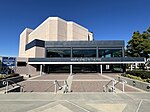Irvine Ranch Water District
1961 establishments in CaliforniaCosta Mesa, CaliforniaGovernment agencies established in 1961Government in Orange County, CaliforniaIrvine, California ... and 5 more
Lake Forest, CaliforniaNewport Beach, CaliforniaOrange, CaliforniaTustin, CaliforniaWater management authorities in California
Irvine Ranch Water District (IRWD) is a California Special District formed in 1961 and incorporated under the California water code. IRWD headquarters are located in Irvine, California. IRWD offers the following services: potable water sales, sewer service and sale of reclaimed (or recycled) water and serves the city of Irvine and portions of Costa Mesa, Lake Forest, Newport Beach, Orange, Tustin and unincorporated areas of Orange County. IRWD has more than 101,000 connections with more than 300,000 customers spanning over 180 square miles (470 km2) of service area in Orange County.
Excerpt from the Wikipedia article Irvine Ranch Water District (License: CC BY-SA 3.0, Authors).Irvine Ranch Water District
Michelson Drive, Irvine Irvine Business Complex
Geographical coordinates (GPS) Address Nearby Places Show on map
Geographical coordinates (GPS)
| Latitude | Longitude |
|---|---|
| N 33.664602325934 ° | E -117.83942384282 ° |
Address
Michelson Drive 3512
92612 Irvine, Irvine Business Complex
California, United States
Open on Google Maps








